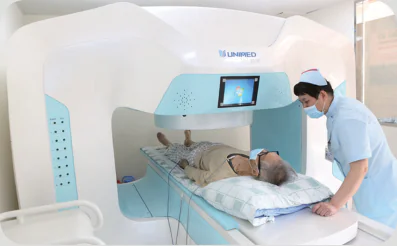
Microwave Hyperthermia Treatment
_____________________________

Schedule Consultation

Schedule Consultation

Theoretical Basis
Unlike normal cells, cancerous cells have a lower tolerance to temperature. Tumor cells can be destroyed by heating them, while normal cells can endure the heat.
Mechanisms
a. Cancer TaX cells contain a high proportion of water. The absorption of microwave radiation by the cancer lesion, both actively and passively, determines the proteins and water cells, which will convert the energy of that microwave into mechanical energy — making water molecules in cells vibrate and spin in place.
Subsequently, when lesion temperatures reach 41–43°C, apoptosis begins through inhibitory mechanisms on ribonucleic acid and DNA sequencing. Apoptotic processes can also be induced by maintaining a temperature of around 40°C — the so-called stagnation phase. This temperature aids in the formation of the “mayonnaise phenomenon,” revealing active substratum degeneration while damaging cell structures. This requires decreases in pH, destroying cancer cells. When tumors are kept at a stable 43°C for half an hour, the cancer frequently obtains a supply but can consume energy rapidly.
b. Because a glomus tumor has abnormal, densely packed blood vessels, the temperature inside the mass rises noticeably higher than in nearby healthy tissue when it is warmed.
Indications
- After the initial treatment of a malignant tumor – reevaluate for recurrence.
- Malignant lesions that have demonstrated metastasizing activity or have potential to spread to remote regions.
- As an adjunct therapy before and after operative treatments.
- Combined treatment with radiotherapy and chemotherapy.
- For patients with cancer who are non-responsive to both surgery and radiation therapy.
- For tumors non-responsive to chemotherapy or those with multi-drug resistance.
- Pleural and ascitic effusion resulting from a malignant tumor.
- Providing palliative care to manage, but not cure, severe cancerous tumors.
Our Specialties & Procedures
Explore our range of advanced cancer care procedures designed to provide comprehensive treatment and improve your well-being.
Advanced Therapies For Cancer
Innovative and precise cancer treatments combining advanced technology, targeted therapy, and personalized medicine for better recovery outcomes.
Explore More →Treating Specific Cancer
Specialized treatment plans for different cancer types — including liver, lung, breast, and bone cancers — with a focus on patient comfort and long-term wellness.
Explore More →Our Specialties & Procedures
Explore our range of advanced cancer care procedures designed to provide comprehensive treatment and improve your well-being.
Advanced Therapies For Cancer
Innovative and precise cancer treatments combining advanced technology, targeted therapy, and personalized medicine for better recovery outcomes.
Explore More →Treating Specific Cancer
Specialized treatment plans for different cancer types — including liver, lung, breast, and bone cancers — with a focus on patient comfort and long-term wellness.
Explore More →ABOUT FUDA CANCER HOSPITAL
OUR ACHIEVEMENTS
Achievements of FUDA CANCER HOSPITAL
50+ Doctors
Professional Experts
1200+ Patients
Happy Indian Patients
100+ Countries
Global Presence
500+ Employees
Dedicated Workforce
Advanced Therapies for Cancer of All Stages
Nano Knife IRE (Irreversible Electroporation)
Cryotherapy | Cryosurgery | Cryo-ablation
Brachytherapy for Cancer
Microvascular Interventional Chemotherapy
Patient Testimonials
Mrs. Pratibha Rajgopal
Mrs. Dipikabehan Parmar
Mrs. Roseline Chandran
Mrs. Jyoti Bhatia
